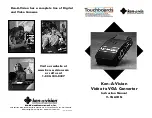
Version: 20220420
10
The power and alarm connectors support stranded and solid wires with diameter up to maximum 1,5 mm².
The required number of conductors for the power + alarm cable depends on the type of connection to the fire control
panel.
•
One conductor pair is required for power.
•
Alarm and Fault signals. In most cases, each require a pair of conductors. Some I/O modules allow to
combine these signals on a single pair of wires through the use of termination resistors. Consult your Fire
Alarm Control Panel documentation to verify what is supported.
•
Optionally one pair of conductors for additional signals that can be used on your Fire Alarm Control Panel.
e.g. separate smoke and flame alarm or supervisory signal.
For installations that are connected to the fire alarm control panel, the power/alarm cabling should be compliant to
local fire regulations e.g. fire-resistant or enhanced fire-resisting cable class, local codes of practice, colour codes,
etc. and compliant with the fire control equipment manufacturer specifications or guidelines. Regulatory
requirements and manufacturer guidelines supersede any further information. Refer to the related standards and
documentation for details.
The power drop at the FireCatcher Camera should not exceed 10%. With a supply voltage of 24VDC and a maximum
power consumption P
max
= 10,7 W, this limits the length of copper wire at an ambient temperature of 20°C to these
values:
Wire conductor gauge
0,75 mm²
18 AWG
1 mm
17 AWG
1,5 mm²
16 AWG
Maximum cable length
(Ah)
100 m
140 m
210 m
Camera positioning
SITE ASSESSMENT
To maximize protection, it is recommended to perform a site survey before installing the FireCatcher Camera. This
allows you to identify risk areas and take those into account when positioning new cameras.
•
Define the hot spots:
What is the type of risk? Can the fire start at any location in the field of view or is there a specific risk related to
machinery or a critical part in the scene?
•
For smoke detection, estimate the smoke flow:
Estimate where smoke may flow in case of an incident. Based on this estimation, preferably select a camera
position that will visualize the smoke in the fastest and largest way. Focus on where the smoke will flow, rather
than the risk area.
Will smoke ascend to the ceiling or will there be stratification?
Will smoke be dispersed over the whole area by ventilation or forced air flow?
•
System redundancy:
To guarantee full coverage on very large areas, multiple cameras will be needed. To avoid blind spots, make
sure the field of views of the cameras overlap with a minimum of 20%.
ENVIRONMENTAL REQUIREMENTS
The sensitivity and performance of the FireCatcher Camera system is impacted partially by the environment it is
operating in. Consider these basic guidelines with each installation for optimal performance:
Light:
For smoke detection, there should be sufficient light 24/7 in the entire field of view.











































